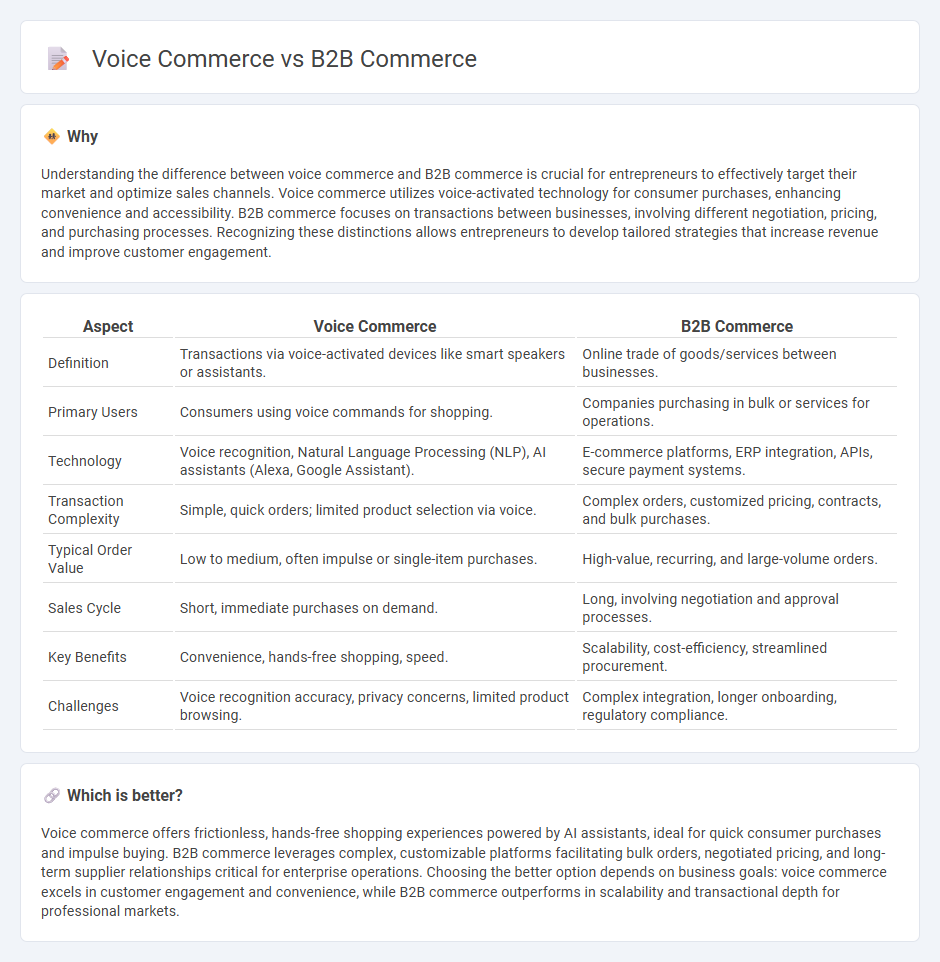
Voice commerce leverages voice-activated devices to streamline purchasing processes, enhancing customer convenience and engagement through natural language interaction. B2B commerce focuses on bulk transactions between businesses, emphasizing efficiency, contract management, and integration with supply chain systems. Explore the differences in strategies and technologies driving these transformative commerce models.
Why it is important
Understanding the difference between voice commerce and B2B commerce is crucial for entrepreneurs to effectively target their market and optimize sales channels. Voice commerce utilizes voice-activated technology for consumer purchases, enhancing convenience and accessibility. B2B commerce focuses on transactions between businesses, involving different negotiation, pricing, and purchasing processes. Recognizing these distinctions allows entrepreneurs to develop tailored strategies that increase revenue and improve customer engagement.
Comparison Table
| Aspect | Voice Commerce | B2B Commerce |
|---|---|---|
| Definition | Transactions via voice-activated devices like smart speakers or assistants. | Online trade of goods/services between businesses. |
| Primary Users | Consumers using voice commands for shopping. | Companies purchasing in bulk or services for operations. |
| Technology | Voice recognition, Natural Language Processing (NLP), AI assistants (Alexa, Google Assistant). | E-commerce platforms, ERP integration, APIs, secure payment systems. |
| Transaction Complexity | Simple, quick orders; limited product selection via voice. | Complex orders, customized pricing, contracts, and bulk purchases. |
| Typical Order Value | Low to medium, often impulse or single-item purchases. | High-value, recurring, and large-volume orders. |
| Sales Cycle | Short, immediate purchases on demand. | Long, involving negotiation and approval processes. |
| Key Benefits | Convenience, hands-free shopping, speed. | Scalability, cost-efficiency, streamlined procurement. |
| Challenges | Voice recognition accuracy, privacy concerns, limited product browsing. | Complex integration, longer onboarding, regulatory compliance. |
Which is better?
Voice commerce offers frictionless, hands-free shopping experiences powered by AI assistants, ideal for quick consumer purchases and impulse buying. B2B commerce leverages complex, customizable platforms facilitating bulk orders, negotiated pricing, and long-term supplier relationships critical for enterprise operations. Choosing the better option depends on business goals: voice commerce excels in customer engagement and convenience, while B2B commerce outperforms in scalability and transactional depth for professional markets.
Connection
Voice commerce enhances B2B commerce by enabling hands-free, efficient ordering and inventory management through voice-activated devices, streamlining procurement processes. Integration of voice technology with B2B platforms reduces transaction times and improves user experience for busy professionals. Leveraging AI-driven voice interfaces supports seamless communication and real-time data access, optimizing supply chain coordination in B2B environments.
Key Terms
**B2B Commerce:**
B2B commerce involves transactions between businesses, emphasizing bulk orders, complex procurement processes, and long-term relationships, often supported by specialized platforms with integrated supply chain management and enhanced security features. It contrasts with voice commerce, which prioritizes consumer convenience and voice-enabled shopping experiences for quick, everyday purchases. Explore how B2B commerce platforms optimize efficiency and drive growth in professional markets.
Supply Chain Management
B2B commerce in supply chain management emphasizes bulk transaction efficiency, supplier relationships, and integrated ERP systems to enhance procurement processes. Voice commerce leverages AI-powered voice assistants to streamline order placements, inventory checks, and real-time communication, reducing operational delays. Explore how these technologies transform supply chain strategies for optimized business performance.
Procurement
B2B commerce streamlines procurement through digital platforms enabling bulk ordering, contract management, and supplier integration to enhance operational efficiency. Voice commerce leverages voice-activated technologies like AI assistants to simplify order placement and inventory checks, reducing manual input errors in procurement processes. Explore how these innovative procurement solutions optimize B2B transactions and voice-driven interfaces for your business advantage.
Source and External Links
What Is B2B Ecommerce? Examples and How to Start - Shopify - B2B ecommerce is the online selling of products or services between businesses, such as manufacturers, wholesalers, retailers, or organizations, focusing on automation, cost reduction, efficiency, and expanding market reach through digital platforms.
What is B2B commerce? - Optimizely - B2B commerce refers to online sales transactions between businesses and involves platforms specialized for handling B2B requirements like recurring payments and customized commerce operations.
What Is B2B Ecommerce? A Complete Guide | Salesforce US - B2B ecommerce handles large, complex orders between businesses, requiring personalized pricing, account-specific terms, and technology that supports bulk purchases and multichannel relationships to enhance customer experience.
 dowidth.com
dowidth.com